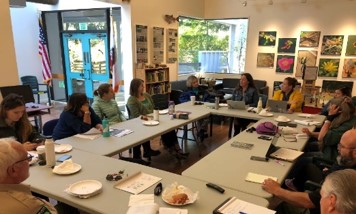
photo © Alison Young, CC BY-NC 2.0
San Mateo County in the San Francisco Bay Area provides a juxtaposition of urban and rural lifestyles, like opposite sides of a single coin. Sandwiched between the Pacific Ocean and San Francisco Bay, and bisected by the Santa Cruz Mountains, San Mateo County is crisscrossed by freeways and hosts a busy international airport and sprawling Silicon Valley tech campuses. A quick jaunt over the mountains and you can spend a lazy day at the beach catching a wave, or hiking by streams and waterfalls in a foggy redwood forest, all signs of the concrete jungle left behind.

photo by R. Cala
Just as diverse as the landscapes of San Mateo County are the members of the San Mateo Marine Protected Area (MPA) Collaborative, a grassroots organization that brings together partners from local non-profits, county, state, and federal agencies, educators, and citizen scientists that are interested in local-level ocean conservation. It is one of 14 collaboratives affiliated with California’s coastal counties, and a part of the MPA Collaborative Network.
There are three MPAs within San Mateo County and one MPA that extends into neighboring Santa Cruz County, all part of the network of 124 MPAs found along the California coast. The MPA Collaborative Network works closely on MPA Management Program activities with the California Department of Fish and Wildlife (CDFW), the lead agency managing California MPAs.

photo courtesy MPACN
Collaborative members support projects that aim to build an inclusive community working together to benefit local MPAs. Members helped design interpretive and regulatory MPA signs to post near heavily used boat ramps in Pillar Point Harbor and on local trails that lead out to Maverick’s Beach near Pillar Point State Marine Conservation Area. Docents from the Friends of Fitzgerald Marine Reserve lead tidepool tours at the popular Fitzgerald Marine Reserve, a part of the Montara State Marine Reserve, and teach visitors proper tidepool etiquette.
Other outreach materials that collaborative members helped to produce include a waterproof brochure summarizing local MPA boundaries and regulations, and a trilingual handout to help enforcement officers and others communicate MPA regulations to a wider audience. Their latest outreach video introduces viewers to the statewide MPA Network, San Mateo County’s local MPAs, and the marine animals, seaweeds, and humans that use the MPAs.
Collaborative co-chairs Rebecca Johnson with the California Academy of Sciences and Rob Cala, a ranger with San Mateo County Parks, are passionate about the collaborative’s mission. “We are dedicated to assisting with education, outreach and enforcement of our local MPAs,” says Johnson. “Our goal is to raise awareness of these special areas to protect them for future generations.”
In 2020 during the global COVID-19 pandemic, the outreach activities of the San Mateo MPA Collaborative became more important than ever. During the shelter-in-place restrictions, a huge influx of people were seen on the beach harvesting invertebrates such as clams, crabs, and mussels. The sandy beach and rocky intertidal areas at Pillar Point were particularly impacted, and CDFW, along with collaborative members, launched an intensive outreach effort to educate visitors about regulations that restrict collecting invertebrates, and protect the nearby MPAs.
Visitors flocking to Pillar Point Reef now pass new signs about tidepool take regulations as they head out to the beach, and San Mateo County Parks is working on installation of a sign at the boundary between the unprotected area of the reef where harvesting is allowed and Pillar Point State Marine Conservation Area, where harvesting is not allowed. Bay Nature, a Bay Area-based nature magazine, highlighted the story unfolding at Pillar Point and interviewed representatives from CDFW and the San Mateo MPA Collaborative. The collaborative is currently working on a long-term outreach and education plan to help conserve the Pillar Point tidepools.
 If you would like to get involved with the San Mateo MPA Collaborative, or any of the other 13 collaboratives, please visit mpacollaborative.org and sign-up to be added to your local collaborative’s mailing list to receive announcements on ocean conservation meetings and events.
If you would like to get involved with the San Mateo MPA Collaborative, or any of the other 13 collaboratives, please visit mpacollaborative.org and sign-up to be added to your local collaborative’s mailing list to receive announcements on ocean conservation meetings and events.
This article has been updated since it was first printed in a CDFW MPA Management Program e-newsletter in May, 2019.
post by Sara Worden, CDFW Environmental Scientist
 This article is part of a series featuring California MPA Collaboratives. Read archived MPA News articles and the series Exploring California’s MPAs for more stories and information about California’s marine protected areas!
This article is part of a series featuring California MPA Collaboratives. Read archived MPA News articles and the series Exploring California’s MPAs for more stories and information about California’s marine protected areas!



